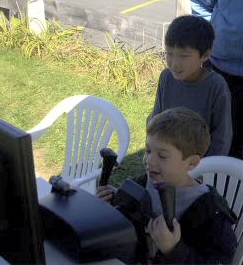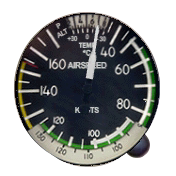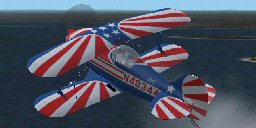 |
|||
|
|||
|
||||||||||||||||||||

Flight Simulator has had
the ability to connect players together through network links since
at least FS95, allowing users to connect with other users and
fly "together" online. It worked well, but it was not
intuitive to set up, and firewalls and other issues tended to
cause problems, making it difficult for the typical customer
to use. Even so, a huge user base grew around a
couple of networks, particularly
VATSIM and
IVAO, as well as many
smaller organizations and groups of people. Realizing the importance of community
flying, the ACES team totally rewrote the multiplayer
functionality for FSX to make it more easily available to
everyone. In this column, I'll cover various aspects of this new feature.
This week's topic covers FS-MP.com, a web-site/community dedicated to providing a "realistic yet relaxed " multiplayer environment for people who want to fly online with others. Their goal is to provide a reliable server for everyone whether you are looking to fly with realistic air traffic control, or are just looking for a place to fly together with others without having to worry about being bothered by people who revel in making trouble by disrupting others online. On its servers you can fly anywhere in the world in the company of others, but, given the relatively small number of controllers currently available at any one time, air traffic control operations are centered around the tri-airport Washington D.C. area. But that area is expanding as we speak, first north to NY and Boston, then south if the demand exists, and during some special events, other airports also will be staffed with controllers. In short, FS-MP offers:
As a member of the FS-MP community, you'll have full access to all these features, whether you are flying within or outside of the air traffic control network when you log on to their servers. Logging online to fly with realistic air traffic control can be intimidating to somebody who's never done it before, but I assure you that this site was developed to help people who've never flown with air traffic control before. As noted, there are tools to help you learn what you need to know to work with controllers, and the controllers are all courteous and helpful so you don't need to worry about being arrested if you make a mistake. If you are confused, just say so and they'll help guide you. The goal of the developers of the site was to develop a server system with realistic air traffic control but that was accessible to everyone. And remember, you don't have to create a flight plan and fly under air traffic control if you don't want to. if you'd rather just test the waters, there's no stopping you from logging in at an uncontrolled airport and either listening in or just flying under Visual Flight Rules (VFR) with no interaction with the controllers. One of the problems with the current FSX multiplayer system is security. As configured by default, sessions are wide open, and susceptible to incursions by "undesirables". FS-MP is password protected and actively policed to avoid this. For instance, there was a problem in the beginning where somebody, with a password, was jumping into people's planes using shared cockpit and messing with people's controls, totally confusing the pilot about what was going on. There are now controls in place on the FS-MP server to eradicate this. To avoid connection problems currently plaguing the Gamespy servers used by default, users connect directly to the FS-MP servers through the Local network (LAN) choice in the "Connection Options" menu. Since this change was implemented, connection issues have almost disappeared completely. One of the things that I really enjoy about the site are the events they regularly sponsor. For instance, on the Sunday before the annual EAA Air Venture event at OshKOSH, one of the largest airshow/fly-in events in the U.S. every year, started, FS-MP sponsored a fly-in using the same approach procedure that are used for the real fly-in. For over 3 hours over 60 people were in the air at the same time on the servers, all approaching and landing at KOSH. Mike Singer at Microsoft wrote a great story about it on FSInsider. All of this work is being done on a volunteer basis headed up by Geoff, who has so far provided all the hardware and software out of his own pocket. Eventually, there may be a small yearly or monthly membership fee (on the order of $5), but currently all these resources have been developed and provided as a free service. Of course any donations are welcome. I definitely recommend you check this site out if you have any interest in flying online. Or even if you don't, try it; who knows, you may find you like it! |
||
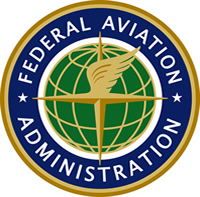
The
Federal Aviation Administration (FAA) is the governing body in
the United States which sets the standards for the entire
aviation industry and for all pilots to make sure that we can
all fly safely from one place to another. They are very particular about making sure pilots are properly trained
and have an inkling of knowledge about what they are doing before
they are allowed to pilot a plane by themselves, much less carry
passengers in the plane. Fortunately,
the FAA is very forthright about what is expected, and there is no
mystery to the process. In fact, the amount of documentation
available on the web today from the FAA is downright
overwhelming. But if you spend the time to look around,
you'll find some real gems out there.
To help start you off, I've listed a few of the handbooks and pamphlets that are handy for the pilot just beginning their training, or studying for their instrument rating, or even for the experienced pilot brushing up on their skills. They contain tons of information about how to fly a plane, and the cool thing is that they are all free. Click on the links below: Airplane Flying Handbook - A good overview of what you'll learn in pilot training Aircraft Weight and Balance Handbook Pilot's Handbook of Aeronautical Knowledge - a huge compendium of everything aeronautical, a must read (but not all at once). Instrument Flying Handbook - This is a very important guide to read, even if you plan on flying in strictly VFR weather. Understanding the concepts in this handbook will make you much more familiar with how to control your airplane no matter what you get hit with. Instrument Procedures Handbook - A companion document to that above. Seaplane, Skiplane, and Float/Ski Equipped Helicopter Operations Handbook Aeronautical Information Manual (AIM) - This book contains ALL the rules by which the FAA governs the airways. You will need to study this in preparation for your oral and written tests. Conducting an effective flight review - Wouldn't it be great if you knew what the teacher was expecting before you took a test. Well, here you go, this is how the FAA expects a flight review to be conducted. If you understand this document, you'll do well at your next flight review. |
||
|
Freeware Spotlight - Milton Shupe,
Scott Thomas and their team
|
||
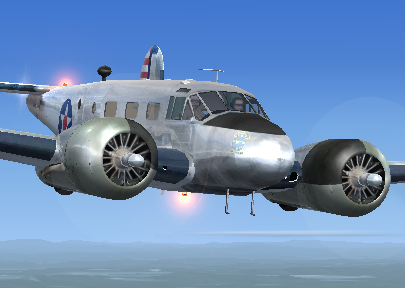
Microsoft's Flight Simulator has been published now for over 25
years. While it certainly can support itself, it's
longevity among enthusiasts is largely due to the HUGE volume
of addons developed by freeware and payware authors. The
sad thing is that it is estimated that perhaps 10% to 20% of
users are even aware that a whole community of users exists
sharing and purchasing aircraft, scenery, and other tools,
supporting each other, and helping to make the product better
every day. The good thing is that Microsoft has finally
seen the light and is actively pushing to make sure that all
users are aware of this community, as shown by a quick perusal
of FSInsider.
One of the premier teams developing freeware aircraft is Milton Shupe, Scott Thomas, and the other members of their team. There are many, many different freeware aircraft available for download, but their aircraft have a life of their own; when you load them up, they make you feel like you are actually sitting in the cockpit. You can almost smell the environment around you. Some of this comes from the aircraft they choose to recreate; classic, slightly out of the mainstream planes that you don't typically see on the tarmac everyday. When you do see one, you know you're looking at something special. But It's also all the little things they do, a magazine here, a folding table there, moving curtains in the windows that open and shut, very realistic panels. If you're looking for a plane to download and try, these planes should absolutely be on your short list. There are developers out there who have developed tens, even
hundreds of aircraft. This is not the case here.
Instead, they have chosen a few planes to produce in great
detail, and their painstaking attention to detail has paid off.
The planes they have chosen are
Milton and Scott have also figured prominently in the design of many other aircraft, such as the recently released Sim-Outhouse A-26 Invader, but these are the aircraft they really call their own. A quick visit to their home site, flightsimonline.com will show the attention to detail they give to their work. For instance, if you click on the link to the Howard 500, you'll find images of the real plane, a story about flying the real plane, a history of the plane, specifications, a copy of the Pilot's Operating Handbook (POH), and lots more. With all these models, you're not just getting a plane, you're getting an experience. While these planes were designed for FS2004, they install easily into FSX with a minimal number of changes. You can download the changes I made to make the aircraft work in FSX here, which basically consist of removal of a couple of non-critical gauges, a few other detail changes to the aircraft.cfg files, and the addition of thumbnail images. See the article below for more information on installing addon aircraft into FSX. |
||
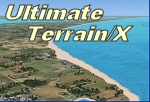
If you were to ask me which product to purchase if you were to only purchase one
addon, a product from the Ultimate Terrain series would be it. Currently, only the
USA product has been released for FSX, but work is ongoing for releases
for Canada, Alaska, and Europe as well. Whereas Canada and Alaska were
combined into a single product for FS2004; for FSX
they were split into separate products, largely because Allen Kriesman, the
developer of the Ultimate Terrain series, is working with the
famous Holger Sandmann to enhance Alaska, really making it a
whole new product.
So, "What is Ultimate Terrain?" you might ask. Its main purpose is to enhance
Flight Simulator so you can actually recognize the land beneath
you if you were to fly over it in real life. While Flight
Simulator makes a fair representation of the world, and FSX does
a much better job than FS2004 did, it really is fairly
simplistic in its coverage and often not very accurate.
The Ultimate Terrain products change all this for the better.
They contain:
Regarding the last feature listed, you might be wondering what "landclass" is. Landclass is data that describes what "type" of terrain goes where; like, where should city buildings be, where should forests be, where should farmland be. It would take terabytes or perhaps more disk space to duplicate the trees and buildings and parking lots of the world in FSX. So, FSX approximates the terrain by splitting the land up into a grid of a little more than 1 km square each, and puts a texture representing the type of "land use" dominating that area into each square. For instance, one texture might represent mostly farmland, another might be filled with suburban streets, another could be a deciduous forest. Each texture square has a mask so the textures can smoothly blend with each other from one to the next if, say, a city texture is placed next to a farmland texture. In this way, FSX can represent the landscape using a relatively small amount of data. I get a lot of questions from people asking about how Ultimate Terrain's landclass compares to and works with the several dedicated landclass products for FSX. One of the features of Ultimate terrain is that you can choose what landclass you want to use. Probably one of the best choices is to layer the Ultimate Terrain City landclass on top of the dedicated landclass so that in the cities, Ultimate Terrain's landclass takes precedence, but outside of the cities the dedicated landclass takes precedence. The assumption is that Ultimate Terrain's city landclass is going to be about as accurate as landclass can be, but less time was spent on the landclass in non-populated areas. The reason Ultimate Terrain's landclass in populated areas is so good is that, rather than using what can be very outdated landclass maps to determine how to distribute terrain textures, which is what most vendors do, Allen used a special algorithm to determine how to distribute cityscapes based on the density of roadways and other information. In fact, however, I've been very pleased with Ultimate Terrain's landclass compared to the dedicated landclass products in the areas that I fly, to the point that I don't even use the dedicated products anymore unless I'm flying in mountainous or other unpopulated terrain. Since its release, comments about Ultimate Terrain/X have been overwhelmingly positive. But there have been a few people who have had some issues with the product. The biggest problem has been that for some people, loading times were increased to as much as 1/2 hour (as opposed to average load times of 30 seconds to 2 minutes). The culprit in most cases was the user's anti-virus program; Avast in particular seemed to be a big culprit. Temporarily turning the anti-virus program off while you fly in FSX fixed the problem in just about all cases. Other people have complained about increases in "the blurries", but, in most situations, reducing the sliders, especially the auto traffic slider, have helped improve things for these users. But even with the auto traffic slider reduced, with Ultimate Terrain/X there is still way more traffic than is in FSX by default. In terms of support, Flight 1 and Allen Kriesman maintain a very active forum for any questions or problems you might have. And if you find any bugs or are looking for enhancements, Allen maintains a set of special tools for reporting issues, with plans for releasing compilations of bug fixes as time goes on. In conclusion, the realism that Ultimate Terrain offers for VFR flying and navigation in terms of the added roads and inland bodies of water, more accurate coastlines and other features it adds makes this product an absolute must have for me, I won't fly without it. With Ultimate Terrain, I readily recognize areas I have flown over in real life. Without it, well, FSX looks pretty good, but I really can't tell where I am if I've flown there before in real life in many cases. This makes Ultimate Terrain very important to me because I like to use Flight Simulator to practice flights I plan to make in real life before I fly them, which really adds to my preparation factor; helping me feel much more confident going to some place I've never been before. And the added auto traffic really brings the sim to life for me. It's not something you can capture in a picture, (believe me, I've tried), but it really adds to the sim experience over all. So, if I were to rate this product out of 5 stars, I would give it a 6. Now, I should acknowledge that I was one of the beta testers for Ultimate Terrain/X. But, one of the reasons I asked to be allowed to do this was that Ultimate Terrain USA for FS2004 blew me away to such a degree I had to be a part of making Ultimate Terrain/X as good as it could be. You be the judge. After all, Flight 1 offers a 30 day money back guarantee if you don't like any product you purchase through them. |
||
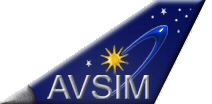
If you haven't noticed, I'm pretty big on promoting involvement
in the community of users supporting Microsoft Flight Simulator
(and every other software title out there). On its own Flight
Simulator has enough pieces to it to keep you occupied for a while,
but once you get involved with the community surrounding it, if you
have an interest in anything aviation, you will be hooked, addicted
perhaps.
Of course, if you want to learn more about the flight simulation community, you've got to start somewhere. One of my favorite places to go is Avsim.com. In fact, to make sure I'm on top of what's going on I visit the site every day. What's there?
All of these services are offered for your use totally for free, supported by an army of volunteers. Of course, donations are welcome, as all this horsepower takes A LOT of money to keep running as smoothly as it does, especially given the expansion of the user community over the last few years. The file library system speaks for itself, as it is one of the principal upload sites for freeware authors around the world. The forums are immense, a great searchable database for any information or help you need, and if you can't find the information you are looking for by searching, if you post a question, you're almost sure to get an answer from somebody within an hour or two or less. So, as I trust you can tell, I think this site should be one you frequent on a regular basis in your quest to be a better flight simulation flyer, hopefully as a participating user. And if you make it out to Seattle in November for the Avsim Conference, look me up! |
||

|
August: Aug 11 9:00 am - 12:00 pm - Young Eagles Free airplane rides for kids 7 - 17 years old. Minuteman Airfield, Stow, MA Aug 11-12, 2007 - The Great New England Air Show Westover AFRB, Chicopee, MA. Aug 11-12, 2007 - Thunder of Niagra Air Show Niagra Falls Air Reserve Station, Niagra Falls, NY Aug 12-16, 2007 - 44th Annual Reno Air Races Reno Stead Field, Reno, NV Aug 18-19, 2007 - Pease "Wings of Hope" Air Show Pease ANGB, Portsmouth, NH. Aug 25-26, 2007 - Otis ANG Air Show Cape Cod, MA. September: Sep 8 9:00 am - 12:00 pm - Young Eagles Free airplane rides for kids 7 - 17 years old. Minuteman Airfield, Stow, MA Sep 15-16, 2007 - Great State of Maine Air Show Naval Air Station Brunswick, Brunswick, ME. November: Nov 9-11, 2007 - Avsim's 2007 conference and exhibition Hilton Hotel and Convention Center, Bellevue, WA |
|
|
I hope you enjoyed this August 2007 Newsletter from Flying'sCool!. If you'd like to write an article for us or would like to see an article on anything about flying or flight simulator just email me and I'll get started on it!! Thanks!!
Sincerely,
Thomas PerryFlying'sCool!
email:
thomas@flyingscool.com
phone:
978-877-6035
|

